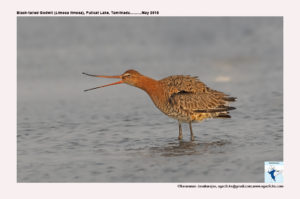Black-tailed Godwit

Black-tailed Godwit Limosa limosa
Etymology :
- Limosa : Latin word muddy derived from limus –
- Limosa : Latin word muddy derived from limus –
Vernacular Names: Sind: Susling, Hindi: Kalidum ka Gudera, Gairiya, Jangral, Sans: Kalpunchi aaramukhi, Bi, Nepal: Malgujha, Ben: Jaurali, Guj: Kalipunchh/Moto gadera, Mar: Kalya shepticha Pantiwala/ Malguja, Khag, Ta: Kannadi ullan, Te: Tondu ulanka, Mal: Pattavalan godwit
Distribution in India: Widespread Winter Visitor in Western and southern mainland and coast, Except for Kerala.
Description: Size of 36-44 cm. It is a tall, elegant Godwit with chestnut breast and upper belly; dark brown barring on belly, with lower belly white; mantle and scapulars blotched pale red, black and grey; long, straightish bill orange pink at base; long legs. Variable numbers of brownish grey feathers in upperparts give untidy, half-moulted look. Female paler and less red than male, with less barring on underparts; bill averages longer. Non-breeding adult pale grey-brown above, greyish white below, with pale greyish Supercilium; lacks chestnut; base of bill fleshy pink.
Habitat: It is found in wet grassland with moderately high grass and soft soil, in lowlands; also grassy marshland, raised bogs and moorland, reclaimed areas and damp grassy depressions in steppe. Winters in sheltered estuaries and lagoons with large intertidal mudflats, sandy beaches, salt-marshes, salt-flats, and inland wetlands, such as swampy lake shores, river pools, flooded grassland and irrigated rice fields.
Food Habits: It eats insects, annelids, molluscs, occasionally seeds and berries during breeding. Non-breeding diet includes smaller annelids, bivalves, crustaceans in intertidal areas, fly larvae in grassland; occasionally tadpoles, small fish and fruits. Feeds by picking and by forward-angled, prolonged probes. Locates food by touch or sight; recorded foot-trembling to disturb prey; sometimes washes food. Usually feeds gregariously in winter and on migration, using communal night-time roosts in shallow water. Chicks on pastures feed very actively on mobile prey in quite tall vegetation.
Breeding Habits: They breed in Apr-June in Russia and Europe. Monogamous on long-term basis. Nest usually on dry, elevated sites, often between clumps of grass; depression lined with bits of vegetation and lichens. They lay a clutch of 2–5 eggs. The incubation period is 20–21 days. Incubation is done by female at night and male during day. Both parents tend young. The fledging period is 28 days; adults depart soon after young fledge.